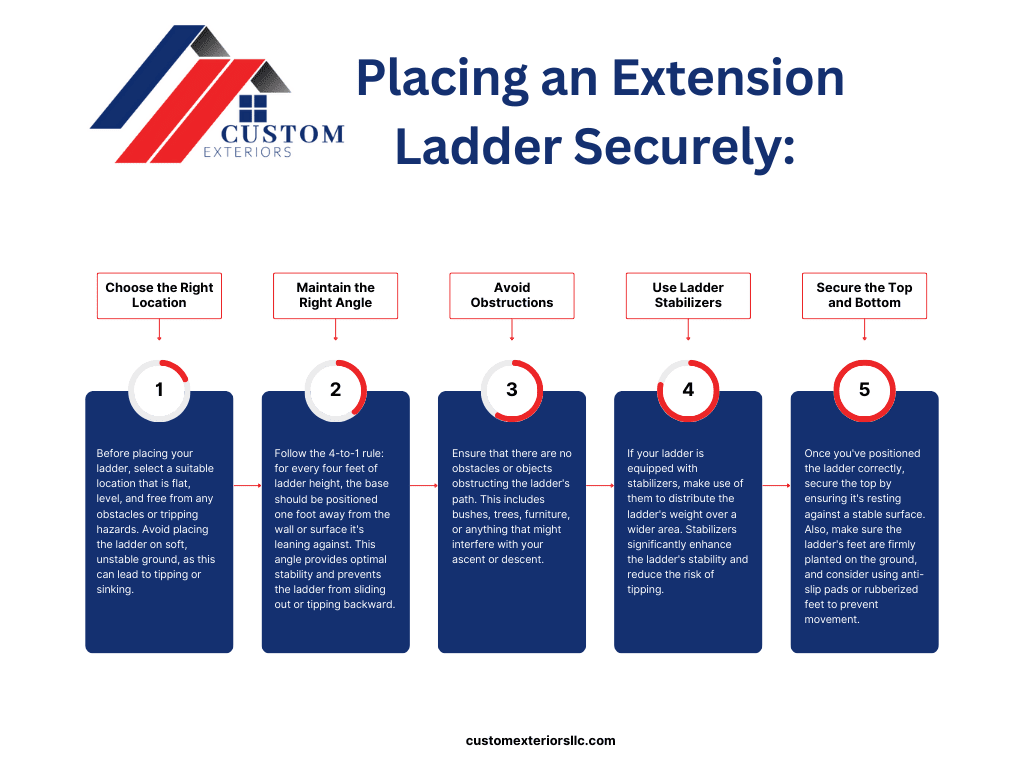
Ladder Safety In Exterior Maintenance
We understand that exterior home maintenance tasks can sometimes take you to greater heights – quite literally. Whether you’re tackling roof repairs, cleaning gutters, or painting that hard-to-reach trim, using a ladder is often a necessary part of the process. However, as much as we prioritize the beauty and value of your home, we prioritize your safety even more.
In this article, we’ll be your guides through the vital aspects of ladder safety in exterior home maintenance. From selecting the perfect ladder for the job to ensuring you’re equipped with the knowledge to inspect, place, and use it correctly, we’ve got you covered. We’ll take you step by step through the essentials, including optional safety equipment and the importance of being aware of your surroundings.
What we will cover:
- When to choose an extension ladder
- Inspecting and placing an extension ladder
- Setting up and climbing safely
- Optional safety equipment
- Awareness of your surroundings
At Custom Exteriors, we believe that a beautiful home starts with a safe home. Let’s discuss the ins and outs of ladder safety to make sure you’re equipped with the knowledge and confidence to tackle your exterior home maintenance tasks with peace of mind.
"More than 22,000 people across the U.S. are injured while using ladders each year. Approximately 65% of those ladder fatalities came from moveable ladders." ~U.S. Bureau of Labor Statistics
Selecting the Appropriate Ladder for Maintenance at heights: Making Safety a Priority
The importance of ladder selection cannot be overstated when tackling tasks that require the use of a ladder, like accessing your roof for inspection or cleaning your gutters. The right ladder improves your efficiency and keeps you safe throughout the process. So, how exactly do you choose the right ladder for roof access and gutter cleaning?
Ladders come in various types, each designed for specific purposes. An extension ladder is a go-to choice for roof access and gutter cleaning due to its versatile design and adjustability. Extension ladders are designed to extend and retract, allowing you to reach different heights easily. Extension ladders are duty-rated from light duty to extra heavy duty. They are generally built with either two or three sections that are able to extend and increase the length of the ladder. These sections are called “Fly Sections.”
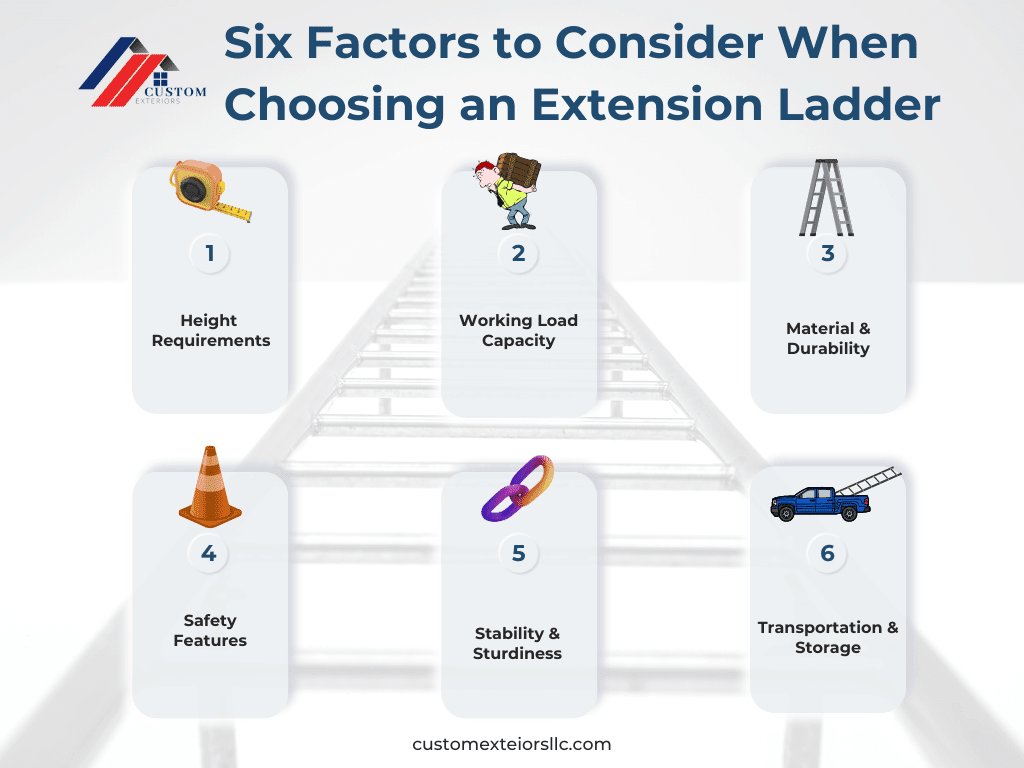
Factors to Consider When Choosing an Extension Ladder
- Appropriate Height
- Weight Limits
- Material Choices
- Additional safety Features
- Ease of use and storage
Height and weight matters
One crucial factor is selecting an extension ladder of the appropriate height. The ladder should be tall enough to comfortably reach the roof or gutter area without requiring you to overextend yourself. Overreaching on a ladder can lead to instability and an increased risk of falling. The ladder should extend past the roof approximately three feet rather than right at the roof line.
It’s important to make sure the ladder you choose can support your body weight and any additional weight from the tools and equipment you’ll be carrying. Extension ladders typically come with a working load capacity rating. Select a ladder that exceeds your combined weight and the weight of your tools. Remember that roof and gutter maintenance can require heavy tools and high-pressure water when choosing the ladder for your home.
Material Choices
Extension ladders are commonly available in aluminum and fiberglass. Aluminum ladders are lightweight and rust-resistant, while fiberglass ladders are non-conductive but generally heavier. Choose the material that best suits your needs and environment. When choosing which material best suits you, consider your personal strength limitations, surrounding hazards (like electrical lines), and the ladder’s intended use.
A ladder with sturdy construction and solid locks helps protect you while working at heights. Features like swivel feet and rubberized bases provide better stability on different surfaces.
safety and storage
Look for extension ladders with safety features like rung locks, non-slip rungs, and stabilizing mechanisms. These features enhance stability and prevent accidents.
Lastly, consider the portability and storage requirements of the ladder. Extension ladders can be long when fully extended, so ensure adequate storage space. There are models available that compress for storage and transportation, but extended height may be smaller, which may not work for some homeowners.
Selecting the appropriate ladder is the foundation for successful and safe roof access and gutter cleaning. A ladder that is appropriately sized, capable of supporting your weight and equipment, and equipped with necessary safety features will significantly reduce the risks associated with working at heights. Remember, choosing the right ladder is an investment in your safety and peace of mind. Prioritize safety and ensure that each time you use the ladder, you can apply some simple steps to help increase your safety level while working at heights. .
Inspecting an extension Ladder
Before you start any exterior home maintenance project, establishing a rock-solid ladder safety foundation is crucial. This step involves two critical aspects: performing a thorough ladder inspection and mastering the art of securely placing your extension ladder.
Before climbing a ladder, always check the following:
- Structural Integrity
- Rung locks & spreaders
- Stabilizers & Feet
Inspections lead to safe repairs
When it comes to ladder inspection, start by checking the ladder’s structural integrity. Examine its rails, rungs, and joints for any signs of rust, cracks, or damage. Ensuring that the rung locks and spreaders are functioning correctly is important because these components contribute to the ladder’s stability while in use. Don’t overlook the stabilizers and feet – they play a significant role in preventing slippage and wobbling.
At Custom Exteriors, we emphasize the significance of these ladder safety steps. Our goal is to empower you with the knowledge to approach your exterior home maintenance tasks confidently, knowing that you’ve laid the groundwork for a safe and successful experience.

Mastering the Art of Placing an Extension Ladder Securely
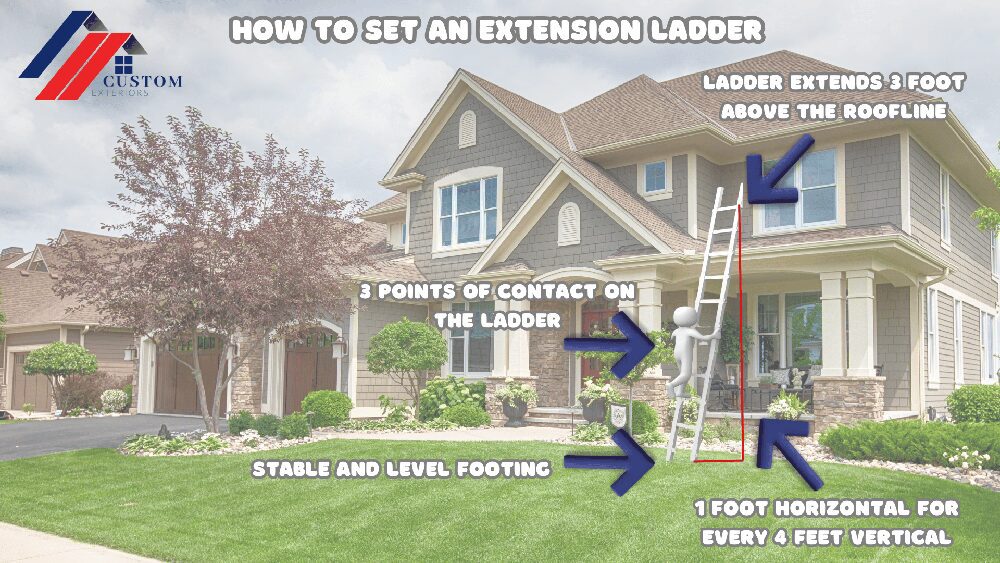
At Custom Exteriors, we are passionate about upgrading your exteriors and beautifying your exteriors – we’re equally passionate about your safety. Placing a ladder might seem like a straightforward task, but it’s a critical step that sets the tone for a secure and successful exterior home improvement project.
Placing a ladder properly goes beyond simply propping it against a surface. It involves strategic decisions that directly impact your safety while working at heights. Here’s why it matters:
-
1. Stability First, Always:
The primary goal of placing a ladder correctly is to establish stability. A ladder that wobbles or shifts while you're on it can lead to accidents and injuries. You create a secure and stable foundation for your work by adhering to proper placement techniques.
-
2. Preventing Slippage and Tipping:
Proper ladder placement helps prevent slippage or tipping during your ascent or descent. This is particularly important when dealing with extension ladders that can become top-heavy if not placed at the right angle.
-
3. Optimal Angle for Safety:
Placing the ladder at the correct angle ensures that it's neither too upright nor too slanted. Following the recommended 4-to-1 rule – one foot out for every four feet of ladder height – provides an optimal angle that maximizes stability and minimizes the risk of falls.
-
4. Avoiding Obstacles and Hazards:
Thoughtful placement helps you avoid obstacles that could interfere with your work or cause accidents. By carefully selecting a clear and obstruction-free location, you create a safer environment for your task.
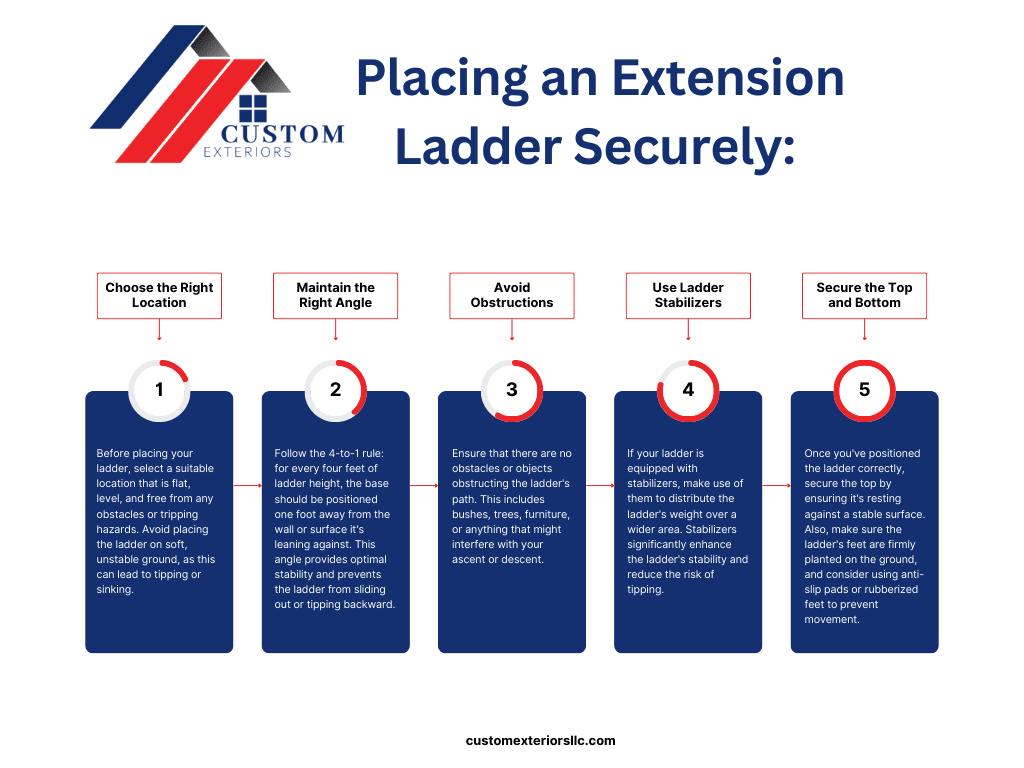
Climbing with Confidence: Safe Climbing Techniques for Extension Ladders

When it comes to exterior home maintenance, mastering the art of climbing an extension ladder is essential. At Custom Exteriors, we’re dedicated to enhancing your home’s appearance and ensuring your safety throughout the process. Let’s explore the proper techniques for climbing an extension ladder safely.
In the previous steps, we learned how to properly place your extension ladder, avoid obstacles, and the best ways to start with a stable foundation. As you can see in the photo above, when setting your ladder, ensure it extends past the roof level by several rungs to ensure safety by being able to exit the ladder onto the roof.
As you begin climbing, always maintain three points of contact with the ladder – two hands and one foot or two feet and one hand. This balanced approach minimizes the risk of tipping. Keep your face on the ladder at all times. Avoid the temptation to twist or turn your body, as it can lead to instability. Remember to ascend or descend one rung at a time, using deliberate and controlled movements. Rushing can compromise your balance and safety.
As you climb, position your hips between the ladder’s side rails as you climb. This technique helps maintain your center of gravity and enhances stability. Lastly, always keep your body within the ladder’s side rails. Overreaching can cause the ladder to become unbalanced, leading to accidents.
Optional Safety Equipment: increasing the safety of your project
At Custom Exteriors, safety is our top priority, which extends to every aspect of your home improvement journey. By following these safe climbing techniques and considering optional safety equipment, you’re equipping yourself with the tools to tackle exterior tasks confidently. Some optional safety equipment you may consider to enhance your safety while maintaining your home include
- Ladder Stabilizers
- Standoff Arms
- Ladder Mitts
- Harnesses and Fall Protection
Ladder stabilizers provide a broader support base at the top of the ladder, reducing swaying and wobbling. Ladder stabilizers are especially useful when working near corners or edges.
Standoff arms create a gap between the ladder and the wall, preventing damage to the surface and offering better stability, especially on uneven surfaces.
Ladder mitts, or cushioned pads, provide extra grip between the ladder and the surface it rests against. They help prevent scratches and improve traction.
Consider using a safety harness and fall protection equipment for tasks requiring prolonged ladder use. Each homeowner should assess their physical limitations, decide if they can do this maintenance, and follow all appropriate safety measures.
Surroundings Awareness: Ladder Safety in Exterior Maintenance
When it comes to exterior home maintenance, the safety of your surroundings is as critical as your ladder skills. Let’s explore why being aware of your surroundings while working with a ladder is essential to safety.
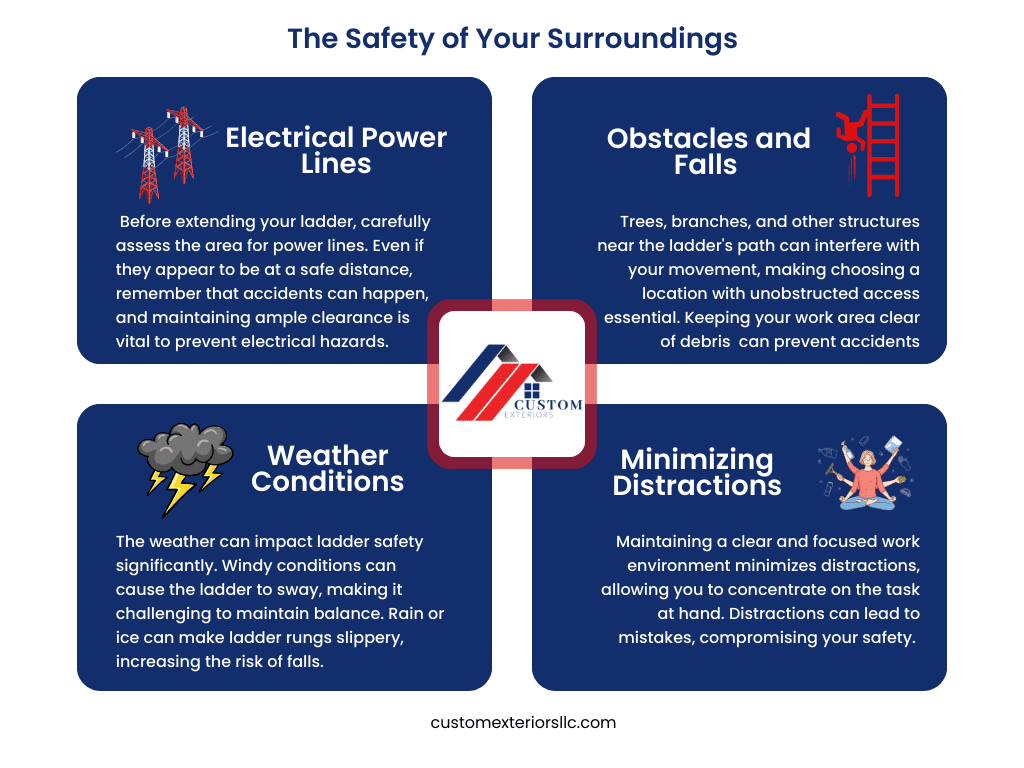
Whether you’re cleaning gutters, repainting, or conducting roof repairs, being vigilant about your surroundings is a non-negotiable aspect of safety. We hope this guide has helped make your exterior home maintenance safer. Our goal is to ensure that you’re equipped with the knowledge and tools to create a secure and transformative home improvement journey. Stay tuned as Custom Exteriors provides more expert insights and we continue to explore ways to improve your safety and make your projects both rewarding and risk-free.
Contact Us Today
We Service and Support the Following Brands





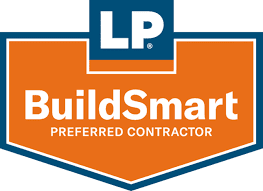



Contact
Custom Exteriors, LLC
2881 S. 31st Ave, Greeley, CO 80631
109 E. 17th St. Ste 5822, Cheyenne, WY 82001
102 S. Tejon St. Ste 1100, Colorado Springs, CO 80903
404 Broadway, Eagle CO 81631
Phone: 970-460-8714
Toll Free: 800-580-0131
Quick Links
© 2022 Custom Exteriors, LLC

